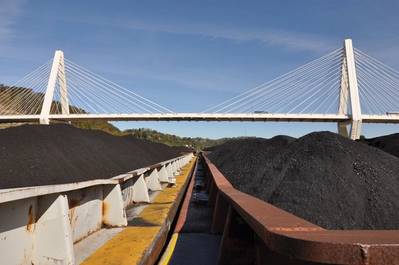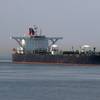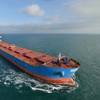US Rail Jams Force Rush to Roads and Rivers
U.S. coal-burning power utilities are being forced to turn to barges and more expensive trucks to move coal, desperate to shore up stockpiles left dangerously low by the widespread bottlenecks on rail networks.
The shift in how coal is being delivered to some power plants from mining regions such as Illinois Basin and comes amid persistent railroad delays that began during last year's severe North American winter.
The delays have been perpetuated also by a surge in rail deliveries of crude oil and grain, leaving power producers such as FirstEnergy Corp scrambling for transport alternatives before winter sets in, potentially adding to costs.
About 40 percent of U.S. power is generated from coal-burning plants, and 75 percent of U.S. coal relies on freight railroads to get to power plants, according to Wood Mackenzie, an energy consultancy.
"We have been impacted by railroad performance but have been able to offset those shortfalls by utilizing truck and barge deliveries," said Stephanie Walton, a spokeswoman for FirstEnergy, whose nine coal-fired plants account for 57 percent of its capacity.
Duke Energy Corp, too, was able to avoid a disruption in coal supply as many of its Midwest plants are accessible by barges, Chief Executive Lynn Good told Reuters.
Although railroads are spending billions to bolster their shipping capacity for coal and other products, industry experts warn that those plans aren't moving fast enough to eliminate the risk of a second straight winter of gridlock on the tracks.
"It may well be that coal that has moved historically by rail is now going to water due to the bottleneck nationwide on rail movements," said Michael Toohey, chief executive of Waterways Council Inc, a trade association for shippers and barge operators.
Toohey estimates that coal shipments by barges are cheaper than rail by about $14 per ton on average.
Coal in Containers
For many utilities, the solution isn't a straight-forward pick from among barges or trucks.
Transporting by barge, while cheaper than rail, is limited to plants located near rivers. Some companies are using third-party docks for barge deliveries and then trucking coal over to power plants that do not have adequate infrastructure.
But trucking is typically used over short distances and is substantially more expensive than barge and rail.
Utilities that sell power at rates set by regulators can pass on additional costs to customers. But companies such as American Electric Power Co Inc and FirstEnergy that sell at competitive prices would be affected, BGC Financial analyst Kit Konolige said.
The workaround for several utilities is intermodal shipment, which cuts fuel costs by 15-20 percent by moving goods in standardized containers using trucks, trains and ships.
According to Justin Long, an analyst at financial services firm Stephens Inc, intermodal shipment volumes rose 6 percent this year.
Currently a stop-gap option, intermodal coal shipments may become more widespread if rail problems continue, Wood Mackenzie analyst Matt Preston said, potentially threatening the long dominant market share of railroads.
Utilities that bank solely on rail still face serious delivery delays, especially on lines run by Berkshire Hathaway Inc's Burlington Northern Santa Fe (BNSF).
Xcel Energy Inc said inventory levels at its Sherco plant in Minnesota - which is served only by BNSF and burns three train loads, or 30,000 tons of coal every day - were "far below optimal levels."
"No other rail carriers can deliver coal to this plant and our permits do not authorize trucking to the plant, so the only thing we can do is push for better service from BNSF," Xcel Energy spokeswoman Mary Sandok said.
The problem is compounded for plants sourcing coal from Wyoming's Powder River Basin, which accounts for 40 percent of total U.S. coal output, but is accessible only by rail.
BNSF said in February it would spend part of its $5 billion capital budget this year to address infrastructure and service issues.
Analysts, however, say it could take a year or more for BNSF to resolve problems, though they expect other railroads to improve their performance in the coming months.
Preston said the fact that utilities will soon have to retire coal plants to comply with environmental regulations could be deterring railroads from improving services to older plants.
"It's unclear how much energy railroads are putting into developing resources, which may be needed only for the next year or two," Preston said.
(By Swetha Gopinath and Sweta Singh; diting by Feroze Jamal)












